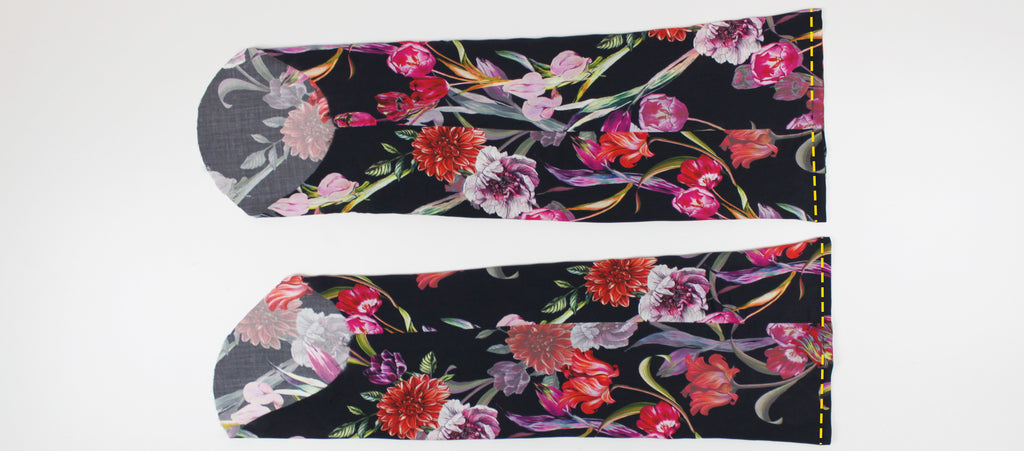The Besima blouse is in the style of the 70s, with casual, wide sleeves and a waterfall neckline. The wide bishop sleeves are gathered with a rubber band. The blouse can be combined casually with jeans or chicly with a skirt.
Length at center back = 62-70 cm
In these instructions, Besima was sewn from a softly falling viscose fabric.
In advance for you as information:
Required material:
We recommend a flowing fabric like silk, viscose, or polyester satin.
Sizes 34-46
- Outer fabric 1.70 m (140 cm wide)
Sizes 48-50
- Outer fabric 2.30 m (140 cm wide)
Sizes 34-50
- Elastic band 0.50 m 0.7 cm wide
- Form tape 0.40 m 12 mm wide
cutting:
Cut out the pattern pieces from your outer fabric . Lay the fabric right side up. Lay the selvedges parallel to the center so that you can lay the front, back and yoke in the fold. The pattern pieces should all be face up. Always align the thread up arrow on all pieces in the same direction and parallel to the selvage of the fabric. Transfer all the notches from the pattern through a 3mm long incision with scissors or with chalk and mark the ends of the darts, note that bust darts are to be processed from larger sizes. Pinch the seam allowance in the fold of the fabric because this is always a center. Markings define positions of dart ends , pocket positions, etc. Transfer these either with chalk or a pin .

You need from fabric:
- 2x pass in break
- 1x back part in break
- 1x front part in break
- 2x sleeves in opposite directions

also with band:
- 1x inner yoke
Sewing instructions:
To sew this shirt you need a sewing machine and an overlock sewing machine, alternatively you can use the zigzag stitch on your sewing machine to finish the raw edges.
In addition to the description, the colorful lines in the pictures show you where a seam needs to be sewn or something to be glued.
When sewing, pay attention to the seam allowance included in the pattern. Seam allowances that are not specially marked are 1 cm wide!
Happy sewing!
Sizes 42-50 have a bust dart, sew it down according to the pattern. A simple, straight dart is closed and sewn on the wrong side of the fabric, snap by snap, tapering from the widest point to the tip

Begin by ironing in and around the hems of the front and back pieces.

Iron the hem of the sleeves with 1cm and 1.5cm around, as there will later be a drawstring for the elastic band.

Lay the inverted pleats in the back piece on top of each other and secure them with an auxiliary seam. Note the arrows in the cut.

Here you can see a detailed view of the box fold.

To finish the yoke, place the outer yoke on the back piece, right sides together, and sew them together.

Place the inner yoke on the other side , right sides together, and sew all three layers together. Then iron the yokes upwards so that the seam allowances in between disappear.

This is what your ironed yoke looks like.

Now comes a somewhat tricky part, because you have to turn the neckline of the yokes together.

To do this, place both yokes right sides together and sew them together. You have to snap in the seam allowances because it is a round neckline.

Here you can see a detailed photo of the yokes.

This is what your tumbled neckline looks like.


Now come to the front of your blouse. There you clean up the upper edge first and then lay the break according to the pattern. Secure the overlapping stretches with an auxiliary seam.

Now place the prepared front piece, right sides together, on the outer yoke and sew them together.

Here you can see a detailed photo of the processing of the left shoulder.

You have to sew the inner yoke a bit more awkwardly, right sides together, onto the front part that has been folded in the fold. The seam allowance between the yokes disappears and is processed neatly.

Here you can see a detailed photo of the processing of the left shoulder.

This is what your finished cutout looks like.

Now place the front and back pieces right sides together and close the side seams. Pay attention to the seam allowances in the pattern. The seam allowances are then neatened together and ironed to the back.

Now take your sleeves and close the inner arm seam. Here, too, the seam allowances are neatened together and ironed to the back.

Stitch the hem of the sleeves just under the edge, don't forget to leave the opening for the drawstring open.

Cut your elastic to the right length and thread it through your tunnel with a safety pin. Sew the two ends together.

Now close your opening and the hem of the sleeve is finished.

Sew the sleeves right sides together into the appropriate armholes and neaten the seam allowances together.

Finally, you stitch through the pre-ironed hem.
Your BESIMA is ready !
If you don't know what to do, or if you have any questions, please send us an email to info@schnittmuster-berlin.de. We will answer you as soon as possible.
Have a lot of fun with your new designer piece!
Sincerely, your Sewing Pattern Berlin team.






